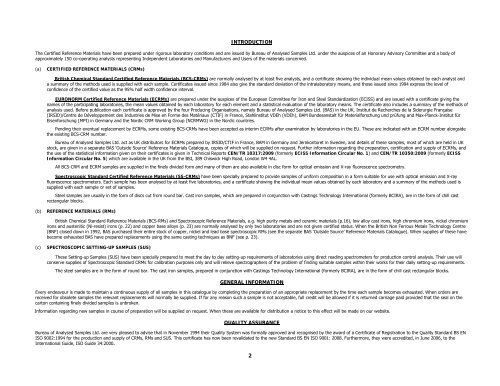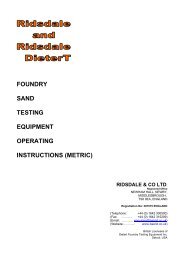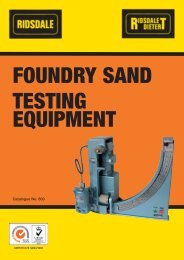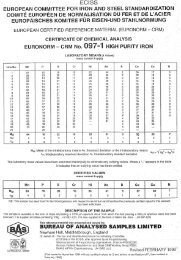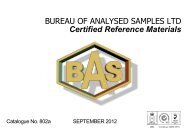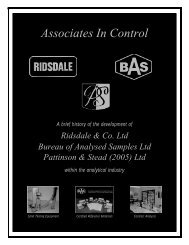BAS Certified Reference Materials - Bureau of Analysed Samples Ltd
BAS Certified Reference Materials - Bureau of Analysed Samples Ltd
BAS Certified Reference Materials - Bureau of Analysed Samples Ltd
Create successful ePaper yourself
Turn your PDF publications into a flip-book with our unique Google optimized e-Paper software.
INTRODUCTION<br />
The <strong>Certified</strong> <strong>Reference</strong> <strong>Materials</strong> have been prepared under rigorous laboratory conditions and are issued by <strong>Bureau</strong> <strong>of</strong> <strong>Analysed</strong> <strong>Samples</strong> <strong>Ltd</strong>. under the auspices <strong>of</strong> an Honorary Advisory Committee and a body <strong>of</strong><br />
approximately 150 co-operating analysts representing Independent Laboratories and Manufacturers and Users <strong>of</strong> the materials concerned.<br />
(a) CERTIFIED REFERENCE MATERIALS (CRMs)<br />
British Chemical Standard <strong>Certified</strong> <strong>Reference</strong> <strong>Materials</strong> (BCS-CRMs) are normally analysed by at least five analysts, and a certificate showing the individual mean values obtained by each analyst and<br />
a summary <strong>of</strong> the methods used is supplied with each sample. Certificates issued since 1984 also give the standard deviation <strong>of</strong> the intralaboratory means, and those issued since 1994 express the level <strong>of</strong><br />
confidence <strong>of</strong> the certified value as the 95% half width confidence interval.<br />
EURONORM <strong>Certified</strong> <strong>Reference</strong> <strong>Materials</strong> (ECRMs) are prepared under the auspices <strong>of</strong> the European Committee for Iron and Steel Standardization (ECISS) and are issued with a certificate giving the<br />
names <strong>of</strong> the participating laboratories, the mean values obtained by each laboratory for each element and a statistical evaluation <strong>of</strong> the laboratory means. The certificate also includes a summary <strong>of</strong> the methods <strong>of</strong><br />
analysis used. Before publication each certificate is approved by the four Producing Organisations, namely <strong>Bureau</strong> <strong>of</strong> <strong>Analysed</strong> <strong>Samples</strong> <strong>Ltd</strong>. (<strong>BAS</strong>) in the UK, Institut de Recherches de la Siderurgie Française<br />
(IRSID)/Centre de Développement des Industries de Mise en Forme des Matériaux (CTIF) in France, Stahlinstitut VDEh (VDEh), BAM Bundesanstalt für Materialforschung und prüfung and Max-Planck-Institut für<br />
Eisenforschung (MPI) in Germany and the Nordic CRM Working Group (NCRMWG) in the Nordic countries.<br />
Pending their eventual replacement by ECRMs, some existing BCS-CRMs have been accepted as interim ECRMs after examination by laboratories in the EU. These are indicated with an ECRM number alongside<br />
the existing BCS-CRM number.<br />
<strong>Bureau</strong> <strong>of</strong> <strong>Analysed</strong> <strong>Samples</strong> <strong>Ltd</strong>. act as UK distributors for ECRMs prepared by IRSID/CTIF in France, BAM in Germany and Jernkontoret in Sweden, and details <strong>of</strong> these samples, most <strong>of</strong> which are held in UK<br />
stock, are given in a separate <strong>BAS</strong> ‘Outside Source’ <strong>Reference</strong> <strong>Materials</strong> Catalogue, copies <strong>of</strong> which will be supplied on request. Further information regarding the preparation, certification and supply <strong>of</strong> ECRMs, and<br />
the use <strong>of</strong> the statistical information given on their certificates is given in Technical Reports CEN/TR 10317:2009 (formerly ECISS Information Circular No. 1) and CEN/TR 10350:2009 (formerly ECISS<br />
Information Circular No. 5) which are available in the UK from the BSI, 389 Chiswick High Road, London W4 4AL.<br />
All BCS-CRM and ECRM samples are supplied in the finely divided form and many <strong>of</strong> them are also available in disc form for optical emission and X-ray fluorescence spectrometry.<br />
Spectroscopic Standard <strong>Certified</strong> <strong>Reference</strong> <strong>Materials</strong> (SS-CRMs) have been specially prepared to provide samples <strong>of</strong> uniform composition in a form suitable for use with optical emission and X-ray<br />
fluorescence spectrometers. Each sample has been analysed by at least five laboratories, and a certificate showing the individual mean values obtained by each laboratory and a summary <strong>of</strong> the methods used is<br />
supplied with each sample or set <strong>of</strong> samples.<br />
Steel samples are usually in the form <strong>of</strong> discs cut from round bar. Cast iron samples, which are prepared in conjunction with Castings Technology International (formerly BCIRA), are in the form <strong>of</strong> chill cast<br />
rectangular blocks.<br />
(b) REFERENCE MATERIALS (RMs)<br />
British Chemical Standard <strong>Reference</strong> <strong>Materials</strong> (BCS-RMs) and Spectroscopic <strong>Reference</strong> <strong>Materials</strong>, e.g. high purity metals and ceramic materials (p.16), low alloy cast irons, high chromium irons, nickel chromium<br />
irons and austenitic (Ni-resist) irons (p. 22) and copper base alloys (p. 23) are normally analysed by only two laboratories and are not given certified status. When the British Non Ferrous Metals Technology Centre<br />
(BNF) closed down in 1992, <strong>BAS</strong> purchased their entire stock <strong>of</strong> copper, nickel and lead base spectroscopic RMs (see the separate <strong>BAS</strong> ‘Outside Source’ <strong>Reference</strong> <strong>Materials</strong> Catalogue). When supplies <strong>of</strong> these have<br />
become exhausted <strong>BAS</strong> have prepared replacements using the same casting techniques as BNF (see p. 23).<br />
(c) SPECTROSCOPIC SETTING-UP SAMPLES (SUS)<br />
These Setting-up <strong>Samples</strong> (SUS) have been specially prepared to meet the day to day setting-up requirements <strong>of</strong> laboratories using direct reading spectrometers for production control analysis. Their use will<br />
conserve supplies <strong>of</strong> Spectroscopic Standard CRMs for calibration purposes only and will relieve spectrographers <strong>of</strong> the problem <strong>of</strong> finding suitable samples within their works for their daily setting-up requirements.<br />
The steel samples are in the form <strong>of</strong> round bar. The cast iron samples, prepared in conjunction with Castings Technology International (formerly BCIRA), are in the form <strong>of</strong> chill cast rectangular blocks.<br />
GENERAL INFORMATION<br />
Every endeavour is made to maintain a continuous supply <strong>of</strong> all samples in this catalogue by completing the preparation <strong>of</strong> an appropriate replacement by the time each sample becomes exhausted. When orders are<br />
received for obsolete samples the relevant replacements will normally be supplied. If for any reason such a sample is not acceptable, full credit will be allowed if it is returned carriage paid provided that the seal on the<br />
carton containing finely divided samples is unbroken.<br />
Information regarding new samples in course <strong>of</strong> preparation will be supplied on request. When these are available for distribution a notice to this effect will be made on our website.<br />
QUALITY ASSURANCE<br />
<strong>Bureau</strong> <strong>of</strong> <strong>Analysed</strong> <strong>Samples</strong> <strong>Ltd</strong>. are very pleased to advise that in November 1994 their Quality System was formally approved and recognised by the award <strong>of</strong> a Certificate <strong>of</strong> Registration to the Quality Standard BS EN<br />
ISO 9002:1994 for the production and supply <strong>of</strong> CRMs, RMs and SUS. This certificate has now been revalidated to the new Standard BS EN ISO 9001: 2008. Furthermore, they were accredited, in June 2006, to the<br />
International Guide, ISO Guide 34:2000.<br />
2


